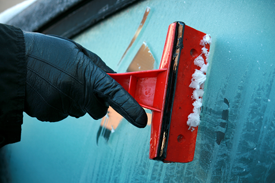Driving when it's icy
It takes at least 10 times longer to stop on icy roads making it one of the most hazardous driving conditions. 
Clear windows
- Make sure all windows and mirrors are completely clear before you set off.
- Use an ice scraper or de-icer.
- Never use hot water as this can cause damage the temperature difference could crack or deform your windscreen.
- Clear front and rear lights, door mirrors, number plates, and if you have them fitted, your front and rear parking cameras.
- Make sure all windows are demisted and not just a small area.
- It is also worth checking that the windscreen wipers aren’t stuck to the screen. If they are you can rip off the rubber blades when you turn them on.
Leave plenty of braking room
- If the car in front suddenly has to stop will you have time to react?
- It can take ten times longer to stop in icy conditions than on a dry road.
- Drive slowly, allowing extra room to slow down and stop.
- A good tip is to be around 20 seconds behind the car in front. Check you are far enough away:
- Watch for the car in front to pass an object, for example a sign or lamp post.
- Count how many seconds go by before you pass the same object.
- If it is less than 20 seconds slow down and leave extra space.
Driving in icy conditions
- Use the highest gear possible to avoid wheel spin.
- Manoeuvre gently, avoiding harsh braking and acceleration.
- To brake on ice or snow without locking your wheels, get into a low gear earlier than normal, allow your speed to fall and use the brake pedal gently.
- If you start to skid, ease off the accelerator, but do not brake suddenly.
